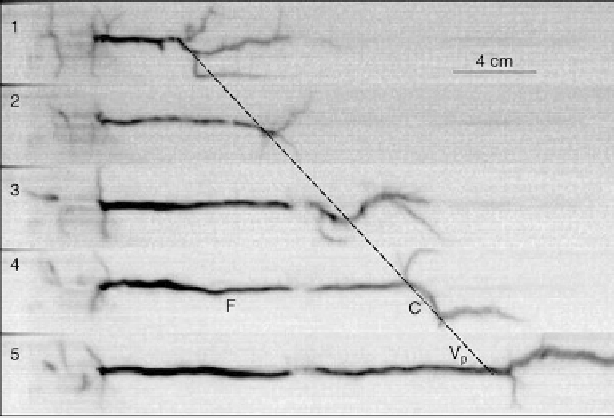Geoscience Reference
In-Depth Information
Fig. 6.4
High-speed
frames of longitudinal plasmoid propagation in swirl flow.
F
plasma
filament,
C
corona. Modulation frequency
F
M
D
250 Hz;
T
i
D
0.5 ms;
V
t
20 m/s;
V
ax
-8 m/s;
U
20 kV; exposure time
t
exp
D
1 s; time interval between the frames
T
f
D
300 s;
V
p
, high-
frequency (
HF
) filament propagation velocity
velocity of a longitudinal vortex plasmoid is close to the typical axial velocity of the
counterflow (the reverse flow):
V
p
V
s
10-30 m/s was swirl flow (Fig.
6.4
). The
velocity
V
p
of longitudinal vortex plasmoid propagation is measured by the high-
speed camera in swirl flow at low static pressure (40-100 Torr) also. The typical
value of
V
p
is about 30-40 m/s, and it does not depend on the swirl flow velocity in
this regime. In this connection one can recall that a typical velocity of BL flowing
out of a socket is also about 1-10 m/s (Barry
1980
; Grigorjev
2006
; Bychkov et al.
2010
).
Plasma parameters inside the longitudinal vortex plasmoid are studied both
by optical spectroscopy and by the optical interferometer. The detailed optical
spectra with a high space resolution were recorded in the different cross sections
of the longitudinal vortex plasmoid created in swirl flow (Figs.
6.5
and
6.6
).
Nonequilibrium processes in the vortex plasmoid are optically studied. The typical
optical spectrum obtained in the longitudinal vortex plasmoid is shown in Fig.
6.5
.
One can see the OH molecular bands and the N
2
2C
molecular bands in this optical
spectrum. These data are processed as represented in Fig.
6.6
. A hot plasma kernel
(with the rotational temperature
T
R
1,500-2,000 K and vibrational temperature
T
V
3,000-4,000 K) is seen inside the longitudinal vortex plasmoid. There is a
“warm” plasma halo (with
T
R
600 K and
T
V
4,000 K) around the longitudinal
vortex plasmoid kernel. There are large temperature gradients in the nonequilibrium
longitudinal vortex plasmoid in this region. So, it is possible to suppose that there is
some relaxation mechanism associated with the vibration-rotation (V-T) relaxation

